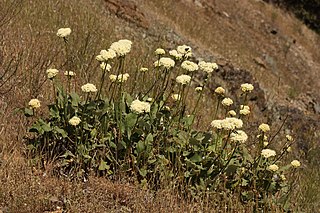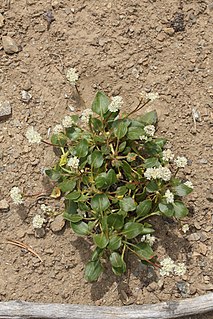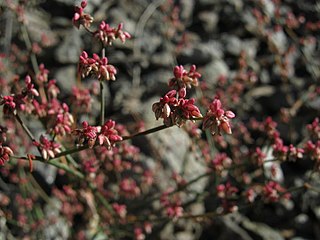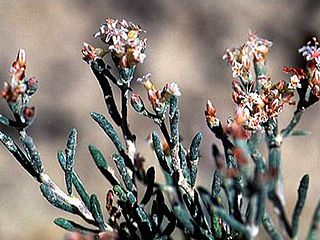
Eriogonum is a genus of flowering plants in the family Polygonaceae. The genus is found in North America and is known as wild buckwheat. This is a highly species-rich genus, and indications are that active speciation is continuing. It includes some common wildflowers such as the California buckwheat.

Eriogonum nudum is a perennial shrub of the wild buckwheat genus which is known by the common name naked buckwheat or nude buckwheat.

Eriogonum alpinum is a species of wild buckwheat known by the common name Trinity buckwheat.

Eriogonum cinereum is a species of wild buckwheat known by the common names coastal buckwheat and ashyleaf buckwheat.

Eriogonum gracilipes is a species of wild buckwheat known by the common name White Mountains buckwheat.

Eriogonum lobbii is a species of wild buckwheat known by the common name Lobb's buckwheat or prostrate buckwheat. It is native to most of the mountain ranges of northern California and their extensions into Oregon and Nevada. It is found in a number of mountain plant communities.

Eriogonum ovalifolium is a species of wild buckwheat known by the common name cushion buckwheat. It is native to western North America from California to Alberta, where it is a member of many plant communities in varied habitats, including the sagebrush steppe and alpine regions.

Eriogonum pyrolifolium is a species of wild buckwheat. It is native to western North America, from British Columbia to the high mountains of California.

Eriogonum saxatile is a species of wild buckwheat known by the common name hoary buckwheat. It is native to the dry, rocky mountain slopes of California and Nevada, where it is a common plant.

Eriogonum wrightii is a species of wild buckwheat known by the common names bastardsage and Wright's buckwheat. It is native to the Southwestern United States, California, and northwest Mexico, where it grows in many plant communities, such as chaparral, in rocky habitats from mountains to deserts.

Eriogonum eremicola is a rare species of wild buckwheat known by the common names Telescope Peak buckwheat and Wild Rose Canyon buckwheat. It is endemic to Inyo County, California, where it is known from only a few occurrences in the Inyo Mountains and Telescope Peak in Death Valley. It grows in sandy to rocky habitat in the forests and woodlands of these desert mountains. It is an annual herb producing a spreading, glandular, reddish green stem up to about 25 centimeters tall. The rounded, woolly leaves are up to about 2.5 centimeters long and are located at the base of the stem. The scattered inflorescences are small clusters of tiny flowers which are white with reddish stripes, aging to solid red, or sometimes yellow. The plant is under protection in Death Valley National Park.

Eriogonum hoffmannii is a species of wild buckwheat known by the common name Hoffmann's buckwheat. It is endemic to Inyo County, California, where it is found only in the mountains around Death Valley; most of the known populations of the plant are located in Death Valley National Park. The plant grows in the desert scrub on the slopes of the Panamint, Black, and Funeral Mountains.

Eriogonum latens is a species of wild buckwheat known by the common name Inyo buckwheat. It is native to the western Great Basin region, in the eastern slopes of the Sierra Nevada and the Inyo Mountains of California and the White Mountains, which extend just into western Nevada. It is an uncommon member of the flora in the sagebrush and woodlands of these mountains, where it grows in granitic sandy soils.

Eriogonum luteolum is a species of wild buckwheat known by the common name goldencarpet buckwheat. It is native to many of the mountain ranges of California and southern Oregon, including the Sierra Nevada, Cascades and California Coast Ranges. It grows in mountain and foothill habitat, such as forest and woodland, on granite and sometimes serpentine soils.

Eriogonum prattenianum is a species of wild buckwheat known by the common name Nevada City buckwheat.

Eriogonum siskiyouense is a rare species of wild buckwheat known by the common name Siskiyou buckwheat.

Eriogonum callistum is a rare species of wild buckwheat, known by the common name Tehachapi buckwheat.

Eriogonum pelinophilum is a rare species of wild buckwheat known by the common name clay-loving wild buckwheat. It is endemic to the state of Colorado in the United States, where it is known from only two counties. The most recent estimates available suggest there are 12 occurrences in existence for a total of about 278,000 individual plants in Delta and Montrose Counties. At least 7 occurrences observed in the past have not been relocated but are not yet believed extirpated. This plant is federally listed as an endangered species of the United States.

Eriogonum niveum is a species of flowering plant in the buckwheat family known by the common name snow buckwheat. It is native to the Pacific Northwest of North America, where it occurs in British Columbia, Washington, Oregon, and Idaho. It flowers late in the summer.

Eriogonum soredium is a species of wild buckwheat known by the common name Frisco buckwheat. It is endemic to Utah in the United States, where it is known only from Beaver County. There are four populations, all located in the San Francisco Mountains. It is a candidate for federal protection.
This page is based on this
Wikipedia article Text is available under the
CC BY-SA 4.0 license; additional terms may apply.
Images, videos and audio are available under their respective licenses.





















